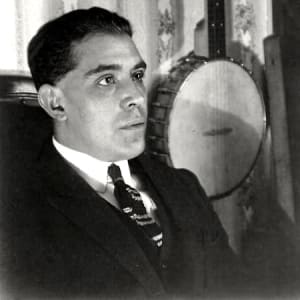
Born on March 23, 1887, in Madrid, Spain, Juan Gris began his artistic career as an illustrator. He became influenced by the Cubist paintings of Pablo Picasso and Georges Braque after moving to Paris and was hailed as one of the movement's leaders during World War I. Gris later designed costumes and sets for a ballet company before dying of renal failure at age 40 in Boulogne-sur-Seine, France.
José Victoriano Carmelo Carlos González-Pérez was born on March 23, 1887, in Madrid, Spain. After studying mathematics, physics, engineering and mechanical drafting at the Escuela de Artes y Manufacturas in Madrid from 1902 to 1904, he embarked on a career as a professional illustrator under the name Juan Gris. He settled permanently in Paris in September 1906, where he met another gifted Spanish artist, Pablo Picasso.
Gris continued to submit illustrations to publications for several years, but he became heavily influenced by the paintings of Picasso and Georges Braque, the creators of Cubism. Devoting significant energy to his own painting after 1910, Gris initially produced works in the Analytic Cubist style, with his use of linear grids and lucid depictions. His Homage to Picasso was among the paintings exhibited at the Salon des Indépendants in 1912, and that same year he signed a contract that gave German art dealer Daniel-Henry Kahnweiler exclusive rights to his work.
Gris's focus soon drifted to Synthetic Cubism, a style marked by a more expansive use of colors and the addition of collage and other materials. The outbreak of World War I disrupted his business relationship with Kahnweiler, but Gris received financial help from writer Gertrude Stein, and he signed a new contract with French dealer Léonce Rosenberg in 1916.
Gris assumed a leading role within the Cubist movement during this time, producing paintings such as The Man from Touraine (1918), which were associated with a sense of classical order. He was awarded his first major solo exhibition at Rosenberg's Galerie l'Effort Moderne in Paris in 1919, but was slowed the following year by an undiagnosed illness that may have been pulmonary tuberculosis.
Along with his painting, Gris designed costumes and sets for Sergei Diaghilev’s Ballets Russes and illustrated texts for Stein and other friends in the 1920s. He enjoyed increased public acclaim and financial security during this period but was unable to bask in his success for long due to declining health. Gris died of renal failure on May 11, 1927, in Boulogne-sur-Seine, France.
"Cubism is not a manner but an aesthetic, and even a state of mind; it is therefore inevitably connected with every manifestation of contemporary thought. It is possible to invent a technique or a manner independently, but one cannot invent the whole complexity of a state of mind."